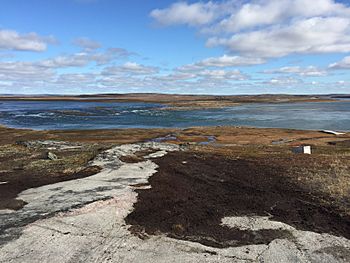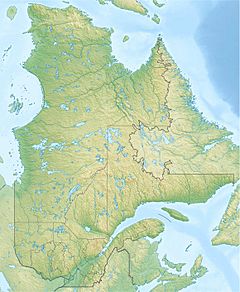Povungnituk River facts for kids
Quick facts for kids Rivière de Puvirnituq |
|
|---|---|

Puvirnituq River - View from the North bank near the village of Puvirnituq - 2017-09-24
|
|
|
Location of the mouth of the river in Quebec
|
|
| Native name | (Former name "Povungnituk River") |
| Other name(s) | Puvirnituq River, Rivière de Povungnituk |
| Country | Canada |
| Province | Quebec |
| Region | Nord-du-Québec |
| District | Kativik |
| Physical characteristics | |
| Main source | Unnamed lake 588 m (1,929 ft) 61°43′32″N 73°18′38″W / 61.72556°N 73.31056°W |
| River mouth | Hudson Bay 0 m (0 ft) 60°01′35″N 77°19′58″W / 60.02639°N 77.33278°W |
| Length | 389 km (242 mi) |
| Basin features | |
| River system | Atlantic Ocean drainage basin |
| Basin size | 28,500 km2 (11,000 sq mi) |
The Puvirnituq River is a long river in Quebec, Canada. It flows through the Nord-du-Québec region. The river is about 389 kilometres (242 mi) long. It starts from a lake and ends in Hudson Bay. The village of Puvirnituq is located at its mouth.
The river's name comes from the Inuktitut language. It means "smells like rotten meat." This might sound strange, but it refers to how animals used to swell up before being opened.
The Puvirnituq River flows near Pingualuit National Park. It crosses the northern edge of this park for about 40.9 kilometres (25.4 mi). Inside the park is the famous Pingualuit crater, a huge meteor impact site. This crater is about 16.7 kilometres (10.4 mi) south of the river.
The river is usually frozen for a big part of the year. It freezes from October to June, and sometimes even into July. In summer, boats can travel about 4 kilometres (2.5 mi) into the bay. They bring supplies to the village of Puvirnituq. Barges then move goods from the boats to the dock. Sometimes, when the ice melts in spring, large ice jams can form.
Many people enjoy sport fishing here. The best spots are near the first three waterfalls. These falls are located about 4 kilometres (2.5 mi), 7 kilometres (4.3 mi), and 10 kilometres (6.2 mi) from where the river meets Hudson Bay.
Contents
Where does the Puvirnituq River flow?
The Puvirnituq River is surrounded by other rivers and lakes. These are part of its watershed. A watershed is an area of land where all the water drains into one main river. The Puvirnituq River's watershed covers a huge area of 28,500 square kilometres (11,000 sq mi).
Here are some of the nearby water bodies:
- North: Qikirtaluup Kuunga River, Little Puvirnituq River
- East: Ungava Bay
- South: North River (Hudson Bay), Lac Guillaume-Delisle, Péloquin Lake, Vachon River, Nantais Lake, Manarsulik Lake
- West: Hudson Bay
The River's Journey from its Start
The Puvirnituq River begins in a small, unnamed mountain lake. This lake is very high up, at an elevation of about 609 metres (1,998 ft). It's located where the water divides between three large bodies of water: Ungava Bay, Hudson Bay, and Hudson Strait.
This starting lake is about 3.3 kilometres (2.1 mi) long and 1.6 kilometres (0.99 mi) wide. It is surrounded by tall mountains. From this lake, the river flows south for about 32.7 kilometres (20.3 mi). It passes through several smaller lakes that are formed by the river widening.
After this, the river turns west and flows for about 20.8 kilometres (12.9 mi). It then flows south again for 1.0 kilometre (0.62 mi). Here, it reaches the northern edge of Pingualuit National Park.
From the park's edge, the Puvirnituq River flows west for about 75 kilometres (47 mi). It then continues for another 48.3 kilometres (30.0 mi). Along this path, it crosses Lake Natirnaaliup Tasinga and another lake. Finally, it flows into the northeast side of Lake Lallemand.
The River's Path to Hudson Bay
After Lake Lallemand, the Puvirnituq River continues its journey. Lake Lallemand is a large lake, about 30.8 kilometres (19.1 mi) long and 18 kilometres (11 mi) wide. It has many islands, peninsulas, and bays. The Little Puvirnituq River flows into Lake Lallemand from the northeast.
From the south end of Lake Lallemand, the river flows through a narrow section about 15.6 kilometres (9.7 mi) long. It then flows south for 6.1 kilometres (3.8 mi) through a wider part of the river. Next, it continues south for 26.6 kilometres (16.5 mi) to Chamberlaine Lake. The river then flows west through Chamberlaine Lake for about 23.3 kilometres (14.5 mi).
The river eventually reaches Puvirnituq Bay, which is part of Hudson Bay. This bay stretches inland for about 9.4 kilometres (5.8 mi). The village of Puvirnituq is on the north shore of this bay. The Formal River also flows into the south shore of this bay.
Main Rivers Joining the Puvirnituq
The Puvirnituq River has two main rivers that flow into it:
- The Little Puvirnituq River: This river flows southwest, almost parallel to the upper part of the Puvirnituq River. It joins the Puvirnituq River at Lake Lallemand.
- The Decoumte River: This river flows from the southeast and joins the Puvirnituq River.
As the Puvirnituq River flows southwest, it passes through Papittukaaq Lake and Puvirnituq Lake. Finally, it empties into the eastern shore of Hudson Bay, right near the village of Puvirnituq.
What's in a Name?
The name "Puvirnituq" is used for many things in this area. It refers to the northern village, a lake, the main river, a smaller river, mountains, and even a national park reserve.
As mentioned earlier, the word "Puvirnituq" comes from the Inuktitut word "puvirniq." This means "rotten meat." It describes how an animal would swell up and rot if it wasn't opened quickly after being hunted.
The official name "rivière de Puvirnituq" was formally recognized on February 23, 1995. This was done by the Commission de toponymie du Québec, which is a group that names places in Quebec.


